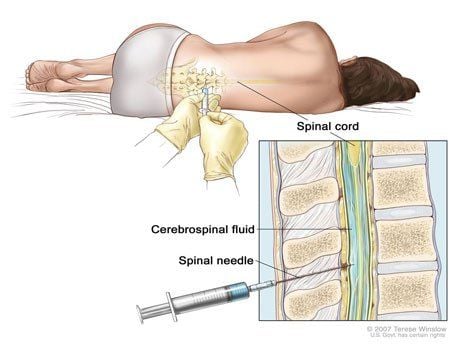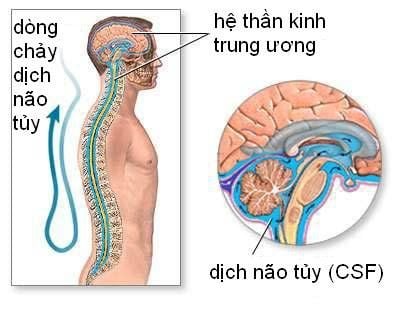This is an automatically translated article.
The article is professionally consulted by Master, Doctor Le Anh Viet - Department of Diagnostic Imaging and Nuclear Medicine - Vinmec Times City International General Hospital. The doctor has 07 years of experience working in the field of diagnostic imaging.Myeloma is an abnormality in which a cyst filled with cerebrospinal fluid forms in the spinal cord. The cyst will grow over time, usually starting in the neck area but it can extend down the entire length of the spinal cord, eventually destroying the center of the spinal cord and affecting the function of the spinal cord. organ. Accordingly, an MRI of the spine should be performed early to evaluate this abnormality.
1. What is hollow marrow disease?
Hollow myelitis is an abnormality in the presence of a fluid-filled cyst called cerebrospinal fluid located in the spinal cord. The growth of the cyst will get bigger and longer over time, damaging the spinal cord and compressing and damaging the nerve fibers that carry information to the brain and from the brain to the rest of the body. CSF is the fluid that normally surrounds and protects the brain and spinal cord. Fluid also fills connected cavities in the center of the brain called the ventricles that continue to a small central tube that runs the length of the spinal cord. In patients with myelodysplasia, cerebrospinal fluid accumulates in the tissue of the spinal cord, widening the central canal and forming cysts. In other words, myelofibrosis develops when the normal flow of cerebrospinal fluid around the spinal cord or the lower brain stem is disrupted, forming a cyst, which compresses the spinal cord structures located in the spinal canal.
The cause of myeloma in most cases is related to Chiari malformation - an abnormal condition in which brain tissue extends through the opening at the base of the skull and into the spinal canal, obstructing the outflow of blood. CSF. In addition, myelofibrosis can also be caused by spinal cord injury, spinal cord tumor, and inflammatory damage around the spinal cord. However, in some cases, the patient has an unknown (idiopathic) cause of the disease.
2. What are the symptoms of hollow marrow disease?
Symptoms of spinal cord injury in myeloma vary among individuals according to the site of formation of the cyst, its size, and how long it has lasted. Symptoms develop slowly over time and can occur on one or both sides of the body, including:
Pain; Gradual weakness in the arms and legs; Stiffness in the back, shoulders, neck, arms, or legs; Headache ; Loss of sensitivity to pain or heat and cold, especially in the hands; Numbness or tingling; Imbalance; Loss of bowel and bladder control; Problems with sexual function; Scoliosis can sometimes be the only symptom in children.

3. How is myeloid disease diagnosed?
To diagnose myelofibrosis, your doctor will review your medical history and perform a physical exam that focuses on nerve function. Your doctor will also likely order pictures of your spine or brain. Occasionally, muscle abnormalities can be found during imaging for another disorder.
Magnetic resonance imaging (MRI) is the most reliable way to diagnose spinal diseases in general and hollow marrow disease in particular. Computer-generated radio waves and a strong magnetic field create clear images of the brain and spinal cord. Using this test, your doctor will be able to determine if there are structural abnormalities in your spine or other abnormalities, such as a tumor.
4. The role of MRI in hollow marrow disease
MRI is the preferred diagnostic method used for diagnosis and differential diagnosis with myeloma.
By using MRI of the spine, the physician can study the abnormal flow of cerebrospinal fluid in the vertebrae, making an important contribution to the understanding of the pathogenesis of the disease as well as being used to select of an appropriate treatment.
Besides, MRI is also important for the postoperative follow-up of patients with myeloproliferative disease, including monitoring of cysts and detection of complications.
Overall, the advantages of MRI in myelofibrosis include:
Investigating cerebrospinal fluid cysts in the spinal cord, especially in cases that have progressed to myeloid after trauma; Determine the lower and upper border of the cyst; Identify the septum in the cyst; Detection of related disorders, such as cysts in the posterior fossa, ligaments, Chiari malformations,... Re-examination after treatment and detection of complications of treatment; Study of the movement of cerebrospinal fluid in the subarachnoid space and in the cyst using flow imaging techniques.
5. How is hollow marrow disease treated?
The treatment modality for myeloproliferative disease depends on the severity and progression of your symptoms in each individual patient.
Follow-up In the absence of symptoms, myelofibrosis is often left untreated. In addition, your doctor may recommend not treating this condition in people who are elderly or in the absence of progression of symptoms. However, the person should be carefully monitored by a neurologist because symptoms may worsen over time. Moreover, the patient also needs to avoid activities that involve stretching the body such as lifting heavy objects, running and jumping... because these actions can aggravate symptoms. Furthermore, people with accompanying Chiari malformation are particularly prone to tension headaches.
Surgery Surgery is usually recommended for people with symptomatic or advanced myeloproliferative disease. There are two types of surgical intervention: restoration of normal cerebrospinal fluid flow around the spinal cord and direct drainage. Which type of treatment to choose depends on the cause of the symptoms.
In summary, myelodysplasia is diagnosed by MRI of the spine. It is the imaging modality of choice in myeloproliferative disease as well as in other spinal cord-related diseases. Accordingly, this indication should be done soon to assess the damage, choose the appropriate treatment and monitor the disease later.
Patients need to go to a reputable hospital to conduct examination and treatment as soon as there are signs of empty marrow disease. Currently, Vinmec International General Hospital is one of the leading prestigious hospitals in the country, trusted by a large number of patients for medical examination and treatment. Not only the physical system, modern equipment: 6 ultrasound rooms, 4 DR X-ray rooms (1 full-axis machine, 1 light machine, 1 general machine and 1 mammography machine) , 2 mobile DR X-ray machines, 2 multi-row CT scanner rooms (1 256 series and 1 512 series), 2 Magnetic resonance imaging rooms (2 3 Tesla machines), 1 angiography room 2-level intervention and 1 room to measure bone mineral density.... Vinmec is also the place to gather a team of experienced doctors and doctors who will greatly assist in the diagnosis and early detection of abnormal signs. usually in the patient's body. In particular, with a space designed according to 5-star hotel standards, Vinmec ensures to bring the patient the most comfort, friendliness and peace of mind.
Please dial HOTLINE for more information or register for an appointment HERE. Download MyVinmec app to make appointments faster and to manage your bookings easily.














